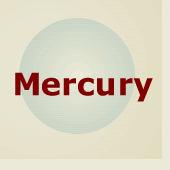Mercury
On This Page

NIOSH Resources
NIOSH Pocket Guide to Chemical Hazards
Exposure limits, Respirator Recommendations, First Aid, more…
The Pocket Guide is a source of general industrial hygiene information on several hundred chemicals/classes found in the work environment. Key data provided for each chemical/substance includes name (including synonyms/trade names), structure/formula, CAS/RTECS Numbers, DOT ID, conversion factors, exposure limits, IDLH, chemical and physical properties, measurement methods, personal protection, respirator recommendations, symptoms, and first aid.
- Mercury compounds [except (organo) alkyls] (as Hg) (CAS No. 7439-97-6 (metal) )
- Mercury (organo) alkyl compounds (as Hg) (CAS No. none)
International Chemical Safety Cards
An ICSC summarizes essential health and safety information on chemicals for their use at the “shop floor” level by workers and employers in factories, agriculture, construction and other work places.
Documentation for Immediately Dangerous to Life or Health Concentrations (IDLH)
The IDLH documents the criteria and information sources that have been used by NIOSH to determine immediately dangerous to life or health concentrations.
NIOSH Manual of Analytical Methods (NMAM)
NMAM is a collection of methods for sampling and analysis of contaminants in workplace air, and in the blood and urine of workers who are occupationally exposed.
- Mercury (No. 6009) [PDF – 23 KB]
The Emergency Response Safety and Health Database (ERSH-DB)
Developed by NIOSH for the emergency response community, The ERSH-DB contains accurate and concise information on high-priority chemical, biological and radiological agents that could be encountered by personnel responding to a terrorist event.
NIOSH Hazard ID No. 6: Exposure to Mercury Vapor During the Use of Mercury Carburetor Synchronizers
DHHS (NIOSH) Publication No. 99-111 (1999)
Presents recommendations for prevention of exposure to Mercury by individuals service engines featuring multiple carburetors.
NIOSH Criteria Documents: Criteria for a Recommended Standard: Occupational Exposure to Inorganic Mercury
DHHS (NIOSH) Publication No. 73-11024 (1973)
Contains a standard for mitigation of exposure to inorganic Mercury to prevent adverse effects over a working lifetime.
Occupational Health Guidelines for Chemical Hazards
DHHS (NIOSH) Publication No. 81-123 (January 1981)
- Inorganic Mercury [PDF – 260 KB]
- Organic Mercury [PDF – 296 KB]
Related Resources
ATSDR’s Medical Management Guidelines (MMGs): Mercury
Agency for Toxic Substances Disease Registry – ToxFAQs: Mercury
Toxicological Profile for Mercury (ATSDR)
OSHA Safety and Health Topics: Mercury
OSHA (Hospital e-Tool): Mercury Spills
OSHA (Occupational Safety and Health Guideline for Mercury Vapor)
OSHA (Healthcare Wide Hazards): Mercury
New Jersey Hazardous Substance Fact Sheets: Mercury
Canadian Centre for Occupational Health and Safety: Mercury
Acute Exposure Guideline Levels (EPA): Mercury Vapor
EPA (Basic Information): Mercury
Integrated Risk Information System (IRIS) (EPA): Mercury (elemental)
NLM (Hazardous Substance Data Bank): Mercury
NTP – CERHR (Reproductive Effects): Mercury
European Chemical Substances Information System (ESIS): Mercury
WHO (CICAD 50): Inorganic Mercury
- Page last reviewed: March 9, 2012
- Page last updated: March 9, 2012
- Content source:
- National Institute for Occupational Safety and Health Education and Information Division


 ShareCompartir
ShareCompartir